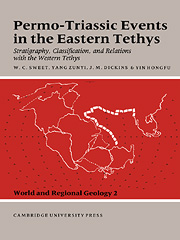 Permo-Triassic Events in the Eastern Tethys
Permo-Triassic Events in the Eastern Tethys Book contents
- Frontmatter
- Contents
- List of contributors
- Preface
- Acknowledgments
- 1 Permo-Triassic events in the eastern Tethys – an overview
- 2 Permo-Triassic boundary relations in South China
- 3 Permo-Triassic boundary of the Indian subcontinent and its intercontinental correlation
- 4 Permo-Triassic boundary on the Indian peninsula
- 5 The Permo-Triassic boundary in the southern and eastern USSR and its international correlation
- 6 Classification and correlation of nonmarine Permo-Triassic boundary in China
- 7 Permian and Triassic events in the continental domains of Mediterranean Europe
- 8 The Permo-Triassic boundary in the Southern Alps (Italy) and in adjacent Periadratic regions
- 9 Permo-Triassic brachiopod successions and events in South China
- 10 Conodont sequences in the Upper Permian and Lower Triassic of South China and the nature of conodont faunal changes at the systemic boundary
- 11 A conodont-based high-resolution biostratigraphy for the Permo-Triassic boundary interval
- 12 The palynofloral succession and palynological events in the Permo-Triassic boundary interval in Israel
- 13 The effects of volcanism on the Permo-Triassic mass extinction in South China
- 14 Geochemical constraints on the Permo-Triassic boundary event in South China
- 15 Permo-Triassic orogenic, paleoclimatic, and eustatic events and their implications for biotic alteration
- 16 Permo-Triassic boundary in Australia and New Zealand
- Index
13 - The effects of volcanism on the Permo-Triassic mass extinction in South China
Published online by Cambridge University Press: 12 October 2009
- Frontmatter
- Contents
- List of contributors
- Preface
- Acknowledgments
- 1 Permo-Triassic events in the eastern Tethys – an overview
- 2 Permo-Triassic boundary relations in South China
- 3 Permo-Triassic boundary of the Indian subcontinent and its intercontinental correlation
- 4 Permo-Triassic boundary on the Indian peninsula
- 5 The Permo-Triassic boundary in the southern and eastern USSR and its international correlation
- 6 Classification and correlation of nonmarine Permo-Triassic boundary in China
- 7 Permian and Triassic events in the continental domains of Mediterranean Europe
- 8 The Permo-Triassic boundary in the Southern Alps (Italy) and in adjacent Periadratic regions
- 9 Permo-Triassic brachiopod successions and events in South China
- 10 Conodont sequences in the Upper Permian and Lower Triassic of South China and the nature of conodont faunal changes at the systemic boundary
- 11 A conodont-based high-resolution biostratigraphy for the Permo-Triassic boundary interval
- 12 The palynofloral succession and palynological events in the Permo-Triassic boundary interval in Israel
- 13 The effects of volcanism on the Permo-Triassic mass extinction in South China
- 14 Geochemical constraints on the Permo-Triassic boundary event in South China
- 15 Permo-Triassic orogenic, paleoclimatic, and eustatic events and their implications for biotic alteration
- 16 Permo-Triassic boundary in Australia and New Zealand
- Index
Summary
Introduction
In this chapter we deal mainly with volcanism in the Permo-Triassic boundary interval in South China, with brief reference to other parts of the Tethyan realm. In much of South China a level commonly regarded as the Permo-Triassic boundary is marked by the so-called ‘boundary clayrock’, which is a layer of montmorillonite or interstratified montmorillonite and illite several centimeters to a few decimeters thick. The boundary clayrock is marine because it yields conodonts, ostracodes, foraminifera, and glauconite, and because its boron content is everywhere much higher than 100 ppm. It is at the level of the boundary clayrock that the strongest phase of Permo-Triassic mass extinction is recorded and it is also at this level that anomalous concentrations of δ13C, iridium, and other elements have been reported.
Permo-Triassic volcanism
Our ideas about volcanism in the Permo-Triassic boundary interval are based on the nature of the boundary clayrock, and on evidence from sphaerules in the boundary clayrock.
Nature of boundary clayrock
More than 30 occurrences of the boundary clayrock and other boundary rocks have been found to be of volcanic origin. The well-known boundary clayrock of the Meishan section, Changxing, Zhejiang Province, was first regarded as sedimentary. However, owing to discoveries in it of high-quartz (beta quartz, Plate 13.1, fig. 8) and other volcanic indicators (He et al., 1987) this layer has been shown to be hydrolyzates of volcanic ash. The equally famous boundary clayrock in the Shangsi section, Guangyuan, Sichuan Province (bed 21 of Yang et al., 1987, or bed 27b of Li et al., 1986) is montmorillonitized tuff (Li et al., 1986).
- Type
- Chapter
- Information
- Permo-Triassic Events in the Eastern TethysStratigraphy Classification and Relations with the Western Tethys, pp. 146 - 157Publisher: Cambridge University PressPrint publication year: 1992
- 8
- Cited by


